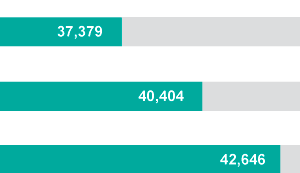Efficiency and quality G4-26 & DMA
SCL expands its outreach and overcomes challenges with structured investments in logistics, information, qualification and safety
Agribusiness represents 22.54% of the GDP and has been growing more than the nation's economy. It involves 5.1 million rural properties. Of these, 27%2 use crop protection. Among mid-sized properties, 36% use such products and, among large ones, 80%. In line with the largest projection for Brazil in the global food scenario and to meet the increasing production needs, the sector has been working on two fronts: expansion of its agricultural frontier, with the entry of new cultivation areas, known as Mapitoba (Maranhão, Piauí, Tocantins and Bahia), and increase in productivity, with growing investments in technology "within the property", such as the use of crop protection.
To keep up with the growing demand, inpEV continuously invests in improving its logistics structure and process and information management, which offer support to the Campo Limpo System. The purpose of the focus on efficiency is to increase receipt capillarity, keep compatible prices and capture value relative to the Institute's activities.
In 2014, the System disposed of 42,646 tons of packaging, which represents a 6% increase when compared to 2013. Of this total, 91% of the packages were recycled. The remaining 9% - consisting of flexible materials that condition hydrophobic products or that were not correctly washed by producers while preparing the product solution applied to the crops - were incinerated. G4-EN28
2 Source: Brazil – Instituto Brasileiro de Geografia e Estatística (IBGE). Agricultural Census (2006), p. 216. Available at: http://www.ibge.gov.br. Accessed on: March 10, 2015.
Disposed packages (t) G4-EN23

Disposal per region - 2014 (%)

Disposal (t)
| State | 2013 | 2014 | Variation (%) |
|---|---|---|---|
| Bahia | 3,254 | 3,298 | 1.4 |
| Espírito Santo | 296 | 369 | 24.5 |
| Goiás | 4,499 | 4,454 | (1.0) |
| Mato Grosso | 9,564 | 9,852 | 3.0 |
| Mato Grosso do Sul | 2,646 | 2,933 | 10.9 |
| Minas Gerais | 3,304 | 3,228 | (2.3) |
| Paraná | 5,003 | 5,367 | 7.3 |
| Pernambuco | 216 | 312 | 44.4 |
| Piauí | 509 | 787 | 54.7 |
| Rio Grande do Sul | 3,753 | 4,479 | 19.4 |
| Rondônia | 246 | 386 | 57.3 |
| Santa Catarina | 615 | 824 | 34.0 |
| São Paulo | 4,769 | 4,816 | 1.0 |
| Tocantins | 278 | 400 | 44.1 |
| Rio de Janeiro | 39 | 57 | 47.6 |
| Others* | 1,415 | 1,082 | (23.5) |
| Totals | 40,404 | 42,646 | 5.5 |
* This represents the sum of the Federal District and the states of Acre, Alagoas, Amazonas, Ceará, Maranhão, Pará, Paraíba, Rio Grande do Norte, Roraima & Sergipe.
Note: variations in the amount disposed of from one year to another in any given state are the result of specific factors, among which: variation in crop protection consumption caused by climate changes, shipping availability, optimizations in logistics and expansion in agricultural frontiers.
Applied knowledge
With the annulment in 2014 of Conama Resolution 334/03 – which prohibited the receipt of product waste or leftovers at receiving units - and its substitution by Conama Resolution 465/14, the Campo Limpo System, coordinated by inpEV, will start to plan to also receive and dispose of packaging with post-consumption product leftovers considered as inadequate. These products are regularly manufactured and commercialized in Brazil, but are either overdue or their packaging has been violated.
Receipt of product leftovers at central stations will not be immediate, since the new resolution foresees physical modifications, changes in operational procedures and the need of a new operational permit at the competent organ. The initial receiving of such leftovers will start still in 2015, and the forecast is that by 2017 all central stations will be adequate and licensed for this new service.
Innovation
Created by inpEV in 2008, the Campo Limpo Plastic Transformation and Recycling closes the reverse logistics cycle of empty post-consumption crop protection packages by offering high quality products to the market. The highlight is Ecoplástica Triex, an innovative packaging for crop protection products that combines fresh resin layers and recycled resin and offers high resistance. It was the first in its category to obtain UN certification (group II , density 1.4 g/cm³) for maritime and ground transportation of hazardous products.
